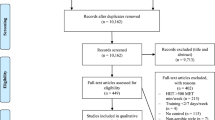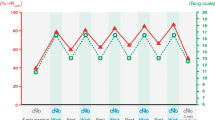Abstract
Despite the promising evidence supporting positive effects of high-intensity interval training (HIIT) on the metabolic profile in adults, there is limited research targeting adolescents. Given the rising burden of chronic disease, it is essential to implement strategies to improve the cardiometabolic health in adolescence, as this is a key stage in the development of healthy lifestyle behaviours. This narrative review summarises evidence of the relative efficacy of HIIT regarding the metabolic health of adolescents. Methodological inconsistencies confound our ability to draw conclusions; however, there is meaningful evidence supporting HIIT as a potentially efficacious exercise modality for use in the adolescent cohort. Future research must examine the effects of various HIIT protocols to determine the optimum strategy to deliver cardiometabolic health benefits. Researchers should explicitly show between-group differences for HIIT intervention and steady-state exercise or control groups, as the magnitude of difference between HIIT and other exercise modalities is of key interest to public health. There is scope for research to examine the palatability of HIIT as an exercise modality for adolescents through investigating perceived enjoyment during and after HIIT, and consequent long-term exercise adherence.
Similar content being viewed by others
References
Andersen LB, Hasselstrøm H, Grønfeldt V, et al. The relationship between physical fitness and clustered risk, and tracking of clustered risk from adolescence to young adulthood: eight years follow-up in the Danish Youth and Sport Study. Int J Behav Nutr Phys Act. 2004;1(6):1–4.
Artero EG, España-Romero V, Jiménez-Pavón D, et al. Muscular fitness, fatness and inflammatory biomarkers in adolescents. Pediatr Obes. Epub 5 Jul 2013. doi:10.1111/j.2047-6310.2013.00186.x.
McCormack SE, McCarthy MA, Harrington SG, et al. Effects of exercise and lifestyle modification on fitness, insulin resistance, skeletal muscle oxidative phosphorylation and intramyocellular lipid content in obese children and adolescents. Pediatr Obes. Epub 25 Jun 2013. doi:10.1111/j.2047-6310.2013.00180.x.
Magnussen CG, Raitakari OT, Thomson R, et al. Utility of currently recommended pediatric dyslipidemia classifications in predicting dyslipidemia in adulthood: evidence from the Childhood Determinants of Adult Health (CDAH) study, Cardiovascular Risk in Young Finns Study, and Bogalusa Heart Study. Circulation. 2008;117(1):32–42.
Dumith SC, Gigante DP, Domingues MR, et al. Physical activity change during adolescence: a systematic review and a pooled analysis. Int J Epidemiol. 2011;40(3):685–98.
Ekelund U, Tomkinson G, Armstrong N. What proportion of youth are physically active? Measurement issues, levels and recent time trends. Br J Sports Med. 2011;45(11):859–65.
O’Donovan G, Blazevich AJ, Boreham C, et al. The ABC of Physical Activity for Health: a consensus statement from the British Association of Sport and Exercise Sciences. J Sports Sci. 2010;28(6):573–91.
Bailey RC, Olson J, Pepper SL, Porszasz J, Barstow TJ, Cooper DM. The level and tempo of children’s physical activities: an observational study. Med Sci Sports Exerc. 1995;27(7):1033–41.
Carson V, Rinaldi RL, Torrance B, et al. Vigorous physical activity and longitudinal associations with cardiometabolic risk factors in youth. Int J Obes (Lond). 2014;38(1):16–21.
Billat LV. Interval training for performance: a scientific and empirical practice. Sports Med. 2001;31(1):13–31.
Gibala MJ. High-intensity interval training: a time-efficient strategy for health promotion? Curr Sports Med Rep. 2007;6(4):211–3.
Trost SG, Owen N, Bauman AE, et al. Correlates of adults’ participation in physical activity: review and update. Med Sci Sports Exerc. 2002;34(12):1996–2001.
Gibala MJ, McGee SL. Metabolic adaptations to short-term high-intensity interval training. Exerc Sport Sci Rev. 2008;36(2):58–63.
Little JP, Safdar A, Bishop D, et al. An acute bout of high-intensity interval training increases the nuclear abundance of PGC-1α and activates mitochondrial biogenesis in human skeletal muscle. Am J Physiol Regul Integr Comp Physiol. 2011;300:R1303–10.
Kemi OJ, Wisloff U. High-intensity aerobic exercise training improves the heart in health and disease. J Cardiopulm Rehabil Prev. 2010;30(1):2–11.
Wisloff U, Ellingsen Ø, Kemi OJ. High-intensity interval training to maximize cardiac benefits of exercise training? Exerc Sport Sci Rev. 2009;37(3):139–46.
Whyte LJ, Gill JMR, Cathcart AJ. Effect of 2 weeks of sprint interval training on health-related outcomes in sedentary overweight/obese men. Metab Clin Exp. 2010;59(10):1421–8.
Kessler HS, Sisson SB, Short KR. The potential for high-intensity interval training to reduce cardiometabolic disease risk. Sports Med. 2012;42(6):489–509.
Crisp NA, Fournier PA, Licari MK, et al. Adding sprints to continuous exercise at the intensity that maximises fat oxidation: implications for acute energy balance and enjoyment. Metab Clin Exp. 2012;61(9):1280–8.
Tjonna AE, Stolen TO, Bye A, et al. Aerobic interval training reduces cardiovascular risk factors more than a multitreatment approach in overweight adolescents. Clin Sci. 2009;116(3–4):317–26.
Buchan DS, Ollis S, Young JD et al. High intensity interval running enhances measures of physical fitness but not metabolic measures of cardiovascular disease risk in healthy adolescents. BMC Public Health 2013;13:498.
Baquet G, Berthoin S, Gerbeaux M, et al. High-intensity aerobic training during a 10 week one-hour physical education cycle: effects on physical fitness of adolescents aged 11 to 16. Int J Sports Med. 2001;22(4):295–300.
Burns SF, Oo HH, Tran AT. Effect of sprint interval exercise on postexercise metabolism and blood pressure in adolescents. Int J Sport Nutr Exerc Metab. 2012;22(1):47–54.
Barker AR, Day J, Smith A, et al. The influence of 2 weeks of low-volume high-intensity interval training on health outcomes in adolescent boys. J Sports Sci. 2014;32(8):757–65.
Burgomaster KA, Hughes SC, Heigenhauser GJF, et al. Six sessions of sprint interval training increases muscle oxidative potential and cycle endurance capacity in humans. J Appl Physiol. 2005;98(6):1985–90.
Hopkins WG, Marshall SW, Batterham AM, et al. Progressive statistics for studies in sports medicine and exercise science. Med Sci Sports Exerc. 2009;41(1):3–13.
Roberts CK, Hevener AL, Barnard RJ. Metabolic syndrome and insulin resistance: underlying causes and modification by exercise training. Compr Physiol. 2013;3(1):1–58.
Buchan DS, Ollis S, Young JD, et al. The effects of time and intensity of exercise on novel and established markers of CVD in adolescent youth. Am J Hum Biol. 2011;23(4):517–26.
Buchan DS, Young JD, Simpson AD. The effects of a novel high intensity exercise intervention on established markers of cardiovascular disease and health in Scottish adolescent youth. J Public Health Res. 2012;1(2):e24.
Andersen LB, Riddoch C, Kriemler S, et al. Physical activity and cardiovascular risk factors in children. Br J Sports Med. 2011;45(11):871–6.
Steene-Johannessen J, Kolle E, Andersen LB, et al. Adiposity, aerobic fitness, muscle fitness, and markers of inflammation in children. Med Sci Sports Exerc. 2013;45(4):714–21.
Dobbins M, Husson H, DeCorby K, et al. School-based physical activity programs for promoting physical activity and fitness in children and adolescents aged 6 to 18. Cochrane Database Syst Rev. 2013;(2):CD007651.
Pate RR, Pratt M, Blair SN, et al. Physical activity and public health. A recommendation from the Centers for Disease Control and Prevention and the American College of Sports Medicine. JAMA. 1995;274:402–7.
Corte de Araujo AC, Roschel H, Picanço AR et al. Similar health benefits of endurance and high-intensity interval training in obese children. PLoS ONE 2012;7(8):e42747.
Thackray AE, Barrett LA, Tolfrey K. Acute high-intensity interval running reduces postprandial lipemia in boys. Med Sci Sports Exerc. 2013;45(7):1277–84.
Racil G, Ben Ounis O, Hammouda O, et al. Effects of high vs. moderate exercise intensity during interval training on lipids and adiponectin levels in obese young females. Eur J Appl Physiol 2013;113(10):2531–40.
Boutcher SH. High-intensity intermittent exercise and fat loss. J Obes. 2011;2011(868305):1–10.
Koubaa A, Trabelsi H, Masmoudi L, et al. Effect of intermittent and continuous training on body composition cardio-respiratory fitness and lipid profile in obese adolescents. IOSR-JPBS. 2013;3(2):31–7.
Little JP, Gillen JB, Percival ME, et al. Low-volume high-intensity interval training reduces hyperglycemia and increases muscle mitochondrial capacity in patients with type 2 diabetes. J Appl Physiol. 2011;111(6):1554–60.
Boyd JC, Simpson CA, Jung ME, et al. Reducing the intensity and volume of interval training diminishes cardiovascular adaptation but not mitochondrial biogenesis in overweight/obese men. PLoS ONE. 2013;8(7):e68091.
Bartlett JD, Close GL, MacLaren DPM, et al. High-intensity interval running is perceived to be more enjoyable than moderate-intensity continuous exercise: implications for exercise adherence. J Sports Sci. 2011;29(6):547–53.
Giguere VMC, Green AE, Latimer AE, et al. High-intensity intervals are associated with relatively positive emotional responses and elevated predictors of behaviour change. Med Sci Sports Exerc. 2011;43(1):324–5.
Jung ME, Little JP, Gillen J, et al. It’s not too hard! Perceived enjoyment for high-intensity interval training in type 2 diabetes. Med Sci Sports Exerc. 2011;43(Suppl 1):20.
Wisloff U, Støylen A, Loennechen JP, et al. Superior cardiovascular effect of aerobic interval training versus moderate continuous training in heart failure patients: a randomized study. Circulation. 2007;115(24):3086–94.
Kendzierski D, DeCorby K. Physical Activity Enjoyment Scale: two validation studies. J Sport Exerc Psychol. 1991;13(1):50–64.
Acknowledgements
No funding was received for this review which may have affected analysis or interpretation of data, writing of this manuscript, or the decision to submit for publication. The authors have no conflicts of interest that are directly relevant to the content of this review. Greig R.M. Logan was funded by the Health Research Council of New Zealand PhD scholarship.
Author information
Authors and Affiliations
Corresponding author
Rights and permissions
About this article
Cite this article
Logan, G.R.M., Harris, N., Duncan, S. et al. A Review of Adolescent High-Intensity Interval Training. Sports Med 44, 1071–1085 (2014). https://doi.org/10.1007/s40279-014-0187-5
Published:
Issue Date:
DOI: https://doi.org/10.1007/s40279-014-0187-5




